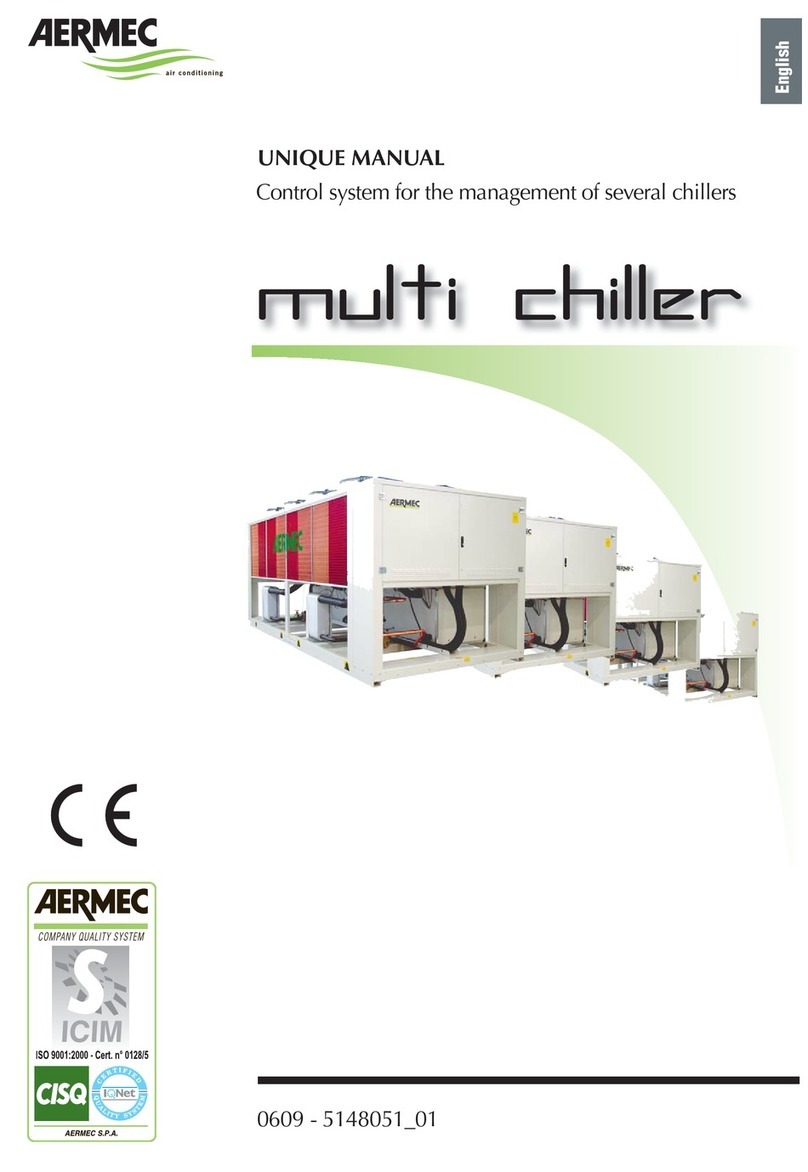
8
2.4 DIP SWITCH SETTING
The board has appropriate conguration dip-switches to meet possible installations. There are 8 microswitches with the following functions:
DIP Position Function
DIP 1 ON Post-treatment resistance presence
OFF Post-treatment resistance not present
DIP 2 ON Pre heating resistance presence
OFF Pre heating resistance not present
DIP 3 ON Post-treatment coil presence
OFF Post-treatment coil not present
DIP 4 ON Recovery unit with heating coil + cooling coil
OFF Recovery unit with heating/cooling coil
DIP 5 ON Freecooling through alternation of the air ow
OFF Freecooling through bypass damper
DIP 6 ON Freecooling dierential with 5°C hysteresis
OFF Freecooling dierential with 2°C hysteresis
DIP 7 ON Dierential pressure switches present
OFF Dierential pressure switches not present
DIP 8 ON Activation dierential according to 3°C electric load
OFF Activation dierential according to 2°C electric load
2.5 SUPERVISION SERIAL
This adjustment standard requires the management of the RS485 serial with which they can be connected as slave to a modbus network. The communication parameters are:
— Modbus RTU
— Baud Rate 19200 bit/s
— Stop bits 2
— No Parity
The following modbus data can be read/written by a supervision system:
LABEL DESCRIPTION CONTROLS VALUE UNIT TYPE ADD
0x03 0x10 MIN MAX
SA_BMS Value read by the room probe SI NO -200 900 °C/10 A 0
SW_BMS Value read by the external coil water probe SI NO -200 900 °C/10 A 1
SAM_BMS Value read by the inow air probe SI NO -200 900 °C/10 A 2
SAE_BMS Value read by the external air probe SI NO -200 900 °C/10 A 3
SINT_BMS Value read by the probe in the user interface SI NO -40 500 °C/10 A 4
SETC_BMS Cold adjustment setpoint value SI NO 80 330 °C/10 A 5
SETH_BMS Hot adjustment setpoint value SI NO 120 400 °C/10 A 6
STATO_BMS Machine status SI NO 0 1 // A 7
MODE_BMS Locally set functioning mode value SI NO 0 3 // A 8
POW1_BMS Fan 1 power SI NO 0 100 % A 9
POW2_BMS Fan 2 power SI NO 0 100 % A 10
ALARM_BMS Alarms found on the recovery unit + recovery unit status ag SI NO 0 8191 // D 11
DIP_BMS Dip_Switch Conguration SI NO 0 255 // D 12
DIGIN_BMS Status of digital inputs SI NO 0 255 // D 13
RELE_BMS Status of electronic board relays SI NO 0 255 // D 14
ENABLE_BMS Enabling from remote and data change ag NO SI 0 1 // D 15
MODER_BMS Remote forced mode value (1: MAN, 2:AUX, 3:AUTO) NO SI 1 3 // A 16
SEASON_BMS Remote forced season value NO SI 0 1 // A 17
SET_POW1_BMS Power set for fan 1 NO SI 0 100 % A 18
SET_POW2_BMS Power set for fan 2 NO SI 0 100 % A 19
SETPOINT_BMS Operating set point NO SI 80 500 °C/10 A 20
HH_FILTRO Operating hours of lters SI NO 0 10000 hours A 21
A: analogue data; D: digital data
The following table describes the digital modbus variables in detail:
LABEL BITS DEFINITION
B1 5 B1 4 B13 B12 B11 B10 B9 B8 B7 B6 B5 B4 B3 B2 B1 B0
ALARM_BM S NU NU NU FLAG_A
F
FLAG_F
C
FLAG_RXO
N
FLAG_FOR
Z
FLAG_VEN
T
ALL_X
X
ALL_F
3
ALL_F
2
ALL_S
A
ALL_SA
M
ALL_SA
E
ALL_DM
P
ALL_DM
F
DIP_BMS NU NU NU NU NU NU NU NU DIP7 DIP6 DIP5 DIP4 DIP3 DIP2 DIP1 DIP0
DIGIN_BMS NU NU NU NU NU NU NU NU NU FI FR FV SP PI EC CC
RELE_BMS NU NU NU NU NU NU NU NU RL6 RL5 RL4 RL3 RL2 RL1 RL0 RL1
ENABLE_BM S NU NU F_SE
TF_V2 F_V1 F_SEA F_M F_A NU NU NU NU NU NU NU ENABLE
Key:
NU bit not used
ALL_DMF freecooling bypass alarm presence bit
ALL_DMP antifreezer bypass alarm presence bit
ALL_SAE external air probe alarm presence bit
ALL_SAM inow air probe alarm presence bit
ALL_SA expelled air probe alarm presence bit




























